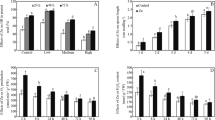Abstract
THE alkali-labile bound form of nicotinic acid (niacinogen) has been isolated as a coloured crystalline compound from different cereals1,2. It is composed of nicotinic acid, a chromophoric moiety or moieties and a peptide, the nicotinic acid being linked through an alkali-labile ester linkage. The occurrence of the niacinogen in cereals suggests a common biological role of this compound in cereal grains. It has been found that in cereals, niacinogen is synthesized in the ripening stage and there is an increase in the nicotinic acid and pyridine nucleotide contents along with a decrease in the niacinogen content during germination3.
This is a preview of subscription content, access via your institution
Access options
Subscribe to this journal
Receive 51 print issues and online access
$199.00 per year
only $3.90 per issue
Buy this article
- Purchase on Springer Link
- Instant access to full article PDF
Prices may be subject to local taxes which are calculated during checkout
Similar content being viewed by others
References
Guha, B. C., and Das, M. L., Nature, 180, 1285 (1957).
Das, M. L., and Guha, B. C., J. Biol. Chem., 235, 2971 (1960).
Ghosh, H. P., thesis, Univ. Calcutta (1962).
Das, M. L., and Ghosh, N. C., Ind. J. Med. Res., 45, 631 (1957).
Kodicek, E., and Reddi, K. K., Nature, 168, 475 (1951).
Author information
Authors and Affiliations
Rights and permissions
About this article
Cite this article
GHOSH, H., SARKAR, P. & GUHA, B. Niacinogen-hydrolysing Enzyme in Extracts from Rice Seedlings. Nature 198, 484–485 (1963). https://doi.org/10.1038/198484a0
Issue Date:
DOI: https://doi.org/10.1038/198484a0
Comments
By submitting a comment you agree to abide by our Terms and Community Guidelines. If you find something abusive or that does not comply with our terms or guidelines please flag it as inappropriate.



